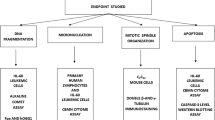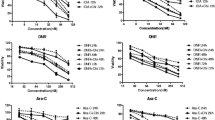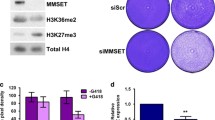Abstract
Cyclophosphamide is one of the most active agents in the treatment of medulloblastoma. However, development of resistance to this alkylator frequently occurs and is the harbinger of tumor progression and death. In order to understand the biochemical basis of this resistance, we generated a panel of medulloblastoma cell lines in our laboratory that were resistant to 4-hydroperoxycyclophosphamide (4-HC). Previously, we have shown that elevated levels of aldehyde dehydrogenase and glutathione mediate cellular resistance to 4-HC. The present study was conducted to identify the third unknown mechanism mediating the resistance of cell line D283 Med (4-HCR) to 4-HC, testing the hypothesis that this resistance is mediated by an increased repair of DNA interstrand crosslinks (ICLs). The doses of 4-HC that produced a one- and two-log cell kill of D283 Med cells were 25 and 50 μM, respectively, compared with values of 125 and 165 μM in D283 Med (4-HCR), the resistant cell line. The formation and disappearance of 4-HC-induced DNA ICLs at the c-myc gene were subsequently studied by DNA denaturing/renaturing gel electrophoresis and Southern blot analysis. 4-HC-induced DNA ICLs in the c-myc gene exhibited a dose-dependent relationship. The percentage of the c-myc gene that was crosslinked was approximately 1–3% at a dose of 100 μM. More than 50% of the DNA crosslinking in D283 Med (4-HCR) cells was removed by 6 h after drug treatment, whereas, in D283 Med cells, more than 90% of the DNA crosslinking was still present at 6 h. These findings suggest that the increased repair of DNA ICLs in D283 Med (4-HCR) may contribute significantly to its resistance to 4-HC.
Similar content being viewed by others
References
Ahmad S, Okine L, Le B, Najarian P, Vistica DT (1987) Elevation of glutathione in phenylalanine mustard-resistant murine L1210 leukemia cells. J Biol Chem 262: 15048
Ali-Osman F, Berger MS, Rajagopal S, Spence A, Livingston RB (1993) Topoisomerase II inhibition and altered kinetics of formation and repair of nitrosourea and cisplatin induced DNA interstrand crosslinks and cytotoxicity in human glioblastoma cells. Cancer Res 53: 5663
Allen JC, Helson L (1981) High-dose cyclophosphamide chemotherapy for recurrent CNS tumors in children. J Neurosurg 55: 749
Allen JC, Helson L, Jereb B (1983) Preradiation chemotherapy for newly diagnosed childhood brain tumors. A modified phase II trial. Cancer 52: 2001
Bigner SH, Friedman HS, Vogelstein B, Oakes WJ, Bigner DD (1990) Amplification of the c-myc gene in human medulloblastoma cell lines and xenografts. Cancer Res 50: 2347
Bohr VA, Phillips DH, Hanawalt PC (1987) Heterogeneous DNA damage and repair in the mammalian genome. Cancer Res 47: 6426
Bungo M, Fujiwara Y, Kasahara K, Nakagawa K, Ohe Y, Sasaki Y, Irino S, Saijo N (1990) Decreased accumulation as a mechanism of resistance tocis-diamminedichloroplatinum(II) in human non-small cell lung cancer cell lines: relation to DNA damage and repair. Cancer Res 50: 2549
Calsou P, Salles B (1993) Role of DNA repair in the mechanisms of cell resistance to alkylating agents and cisplatin. Cancer Chemother Pharmacol 32: 85
Colvin M, Chabner BA (1990) Alkylator agents. In: Chabner BA, Colins JM (eds) Cancer chemotherapy principles and practice. JP Lippincott, Philadelphia, p 276
Colvin OM, Hilton J (1981) Pharmacology of cyclophosphamide and metabolites. Cancer Treat Rep 65 [Suppl 3]: 89
Colvin M, Brundrett RB, Kan MN, Jardine I, Fenselau C (1976) Alkylating properties of phosphoramide mustard. Cancer Res 36: 1121
Frei E III, Cucchi CA, Rosowsky AT, Tantravahi R, Bernal S, Ervin TJ, Ruprecht RM, Haseltine WA (1988) Alkylating agent resistance:in vitro studies with human cell lines. Proc Natl Acad Sci USA 82: 2158
Friedman HS, Burger PC, Bigner SH, Trojanowski JQ, Wikstrand CJ, Halperin EC, Bigner DD (1985) Establishment and characterization of the human medulloblastoma cell line and transplantable xenograft D283 Med. J Neuropathol Exp Neurol 44: 592
Friedman HS, Mahaley MS, Schold SC Jr, Vick NA, Falletta JM, Bullard DE, D'Souza BJ, Khandekar JD, Lew S, Oakes WJ, Bigner DD (1986) Efficacy of vincristine and cyclophosphamide in the therapy of recurrent medulloblastoma. Neurosurgery 18: 335
Friedman HS, Skapek SX, Colvin OM, Elion GB, Blum MR, Savina PM, Hilton J, Schold SC Jr, Kurtzberg J, Bigner DD (1988) Melphalan transport, glutathione levels, and glutathione-S-transferase activity in human medulloblastoma. Cancer Res 48: 5397
Friedman HS, Colvin OM, Kaufmann SH, Ludeman SM, Bullock N, Bigner DD, Griffith OW (1992) Cyclophosphamide resistance in medulloblastoma. Cancer Res 52: 5373
Futscher BW, Pieper RO, Dalton WS, Erickson LC (1992) Gene-specific DNA interstrand cross-links produced by nitrogen mustard in the human tumor cell line Colo320HSR. Cell Growth Differ 3: 217
Hilton J (1984) Role of aldehyde dehydrogenase in cyclophosphamide-resistant L1210 leukemia. Cancer Res 44: 5156
Hilton J (1984) Deoxyribonucleic acid crosslinking by 4-hydroperoxycyclophosphamide in cyclophosphamide-sensitive and-resistant L1210 cells. Biochem Pharmacol 33: 1867
Hubert JJ (1980) Serial dilution assay. In: JJ Hubert (ed) Bioassay. Kendal/Hunt, Dubuque, p 90
Johnson EA, Brown BW (1961) The Spearman estimator for serial dilution assays. Biometrics 17: 79
Larminat F, Zhen W, Bohr VA (1993) Gene-specific DNA repair of interstrand crosslinks induced by chemotherapeutic agents can be preferential. J Biol Chem 268: 2649
Matsumoto A, Vos J, Hanawalt PC (1989) Repair analysis of mitomycin C-induced DNA crosslinking in ribosomal RNA genes in lymphoblastoid cells from Fanconis anemia patients. Mutat Res 217: 185
McGown AT, Fox BW (1986) A proposed mechanism of resistance to cyclophosphamide and phosphoramide mustard in a Yoshida cell linein vitro. Cancer Chemother Pharmacol 17: 223
Redwood WR, Colvin OM (1980) Transport of melphalan by sensitive and resistant L1210 cells. Cancer Res 40: 1144
Russo JE, Hilton J, Colvin OM (1989) The role of aldehyde dehydrogenase isozymes in cellular resistance to the alkylating agent cyclophosphamide. Enzymol Mol Biol Carbonyl Metab 2: 65
Sladek NE (1988) Metabolism of oxazaphosphorines. Pharmacol Ther 37: 301
Sladek NE (1993) Oxazaphosphorine-specific acquired cellular resistance. In: Teider BA (ed) Drug resistance in oncology, Marcel Dekker, New York, p 375
Teicher BA, Cucchi CA, Lee JB, Flatow JL, Rosowsky A, Frei E (1986) Alkylating agents:in vitro studies of cross-resistance patterns in human tumor cell lines. Cancer Res 46: 4879
Vos J-MH, Hanawalt PC (1987) Processing of psoralen adducts in an active human gene: repair and replication of DNA containing monoadducts and interstrand cross-links. Cell 50: 789
Waxman D (1990) Glutathione-S-transferases: role in alkylating agent resistance and possible target for modulation chemotherapy. Cancer Res 50: 6449
Zhen W, Link CJ, OConnor PM, Reed E, Parker R, Howell SB, Bohr VA (1992) Increased gene-specific repair of cisplatin inter-strand cross-links in cisplatin-resistant human ovarian cancer cell lines. Mol Cell Biol 12: 3689
Author information
Authors and Affiliations
Additional information
This work was supported by NIH Grants CA 11898, CA 56115, NS 30245, NS 20093; and ACS Grant DHP-67E
Rights and permissions
About this article
Cite this article
Dong, Q., Bullock, N., Ali-Osman, F. et al. Repair analysis of 4-hydroperoxycyclophosphamide-induced DNA interstrand crosslinking in the c-myc gene in 4-hydroperoxycyclophosphamide-sensitive and-resistant medulloblastoma cell lines. Cancer Chemother. Pharmacol. 37, 242–246 (1995). https://doi.org/10.1007/BF00688323
Received:
Accepted:
Issue Date:
DOI: https://doi.org/10.1007/BF00688323




